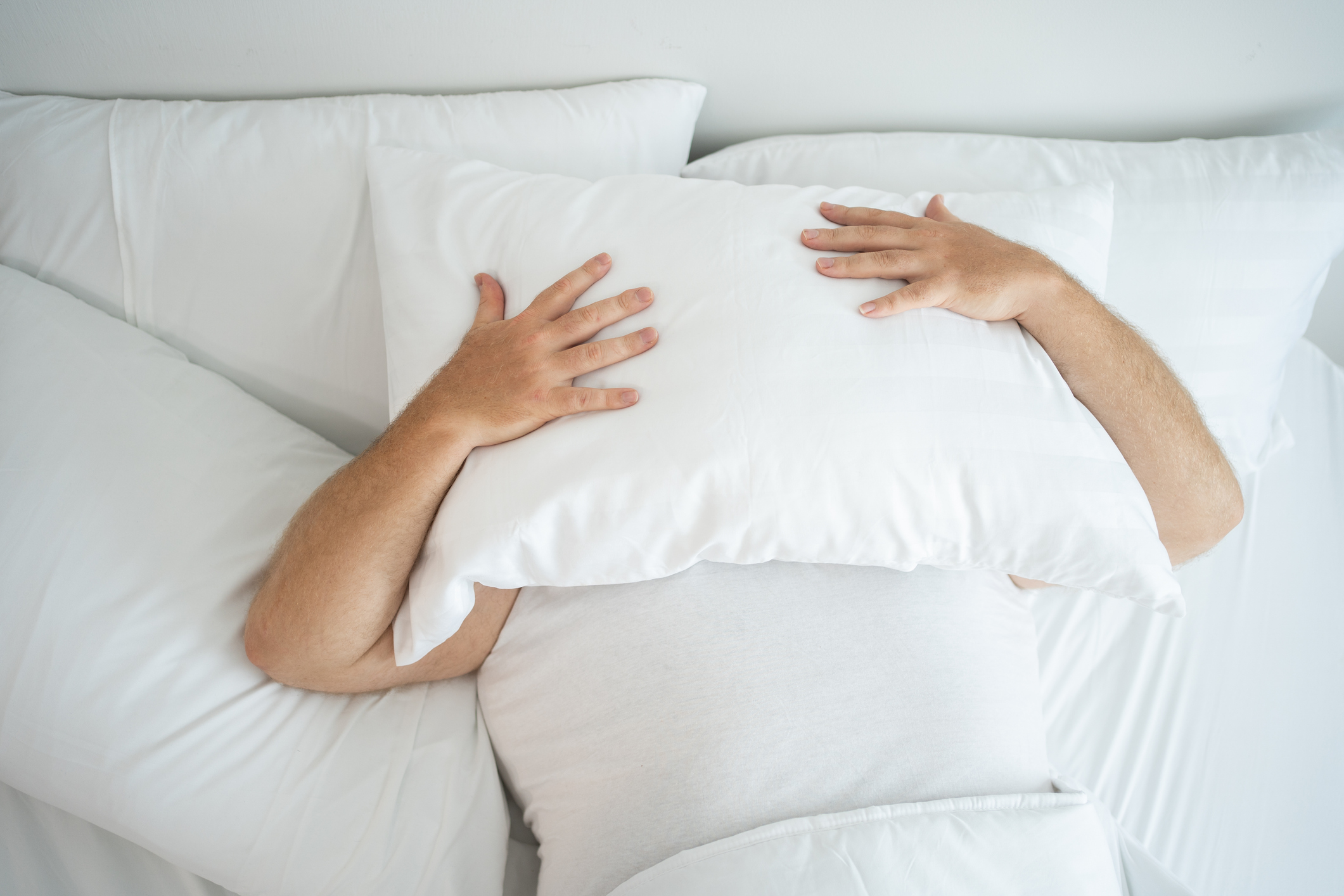Sleep apnea
August 11, 2025
Can Sleep Apnea Be Life-Threatening?
Sleep apnea may put your life at risk. Each time your airway collapses during the night, oxygen drops, blood pressure spikes, and your heart is pushed into overdrive.
Most people with sleep apnea don’t know it’s happening, but their body does. And without proper treatment, that constant stress can lead to long-term damage with serious consequences.
What Happens in the Body During Sleep Apnea?
Sleep apnea is a disorder that causes you to stop breathing repeatedly while asleep. The most common type, obstructive sleep apnea (OSA), happens when the airway muscles in the throat collapse during sleep, blocking airflow. These interruptions, called apneas, typically last 10 to 30 seconds but can occur hundreds of times per night.
Every apnea event reduces blood oxygen levels. In response, your brain triggers a brief awakening to restore breathing. This process activates your sympathetic nervous system, the same system responsible for fight-or-flight responses. As a result, your heart rate spikes, blood pressure surges, and the cycle repeats throughout the night.
The deeper stages of sleep, REM and slow-wave sleep, get disrupted. These stages are critical for memory, hormone regulation, tissue repair, and immune function. With frequent apneas, your sleep architecture becomes fragmented, meaning you never reach fully restorative rest.
The body also produces more inflammatory cytokines, like interleukin-6 and TNF-alpha, which are linked to cardiovascular disease, insulin resistance, and cognitive decline. Sleep apnea, if ignored, can affect your whole body.
Sleep Apnea and Heart
Sleep apnea places immense strain on the cardiovascular system. Each time breathing stops, blood oxygen drops (hypoxemia), carbon dioxide rises (hypercapnia), and the body experiences a surge in blood pressure and heart rate. This constant fluctuation is dangerous, particularly for the heart.
One of the most well-established risks is hypertension. According to the American Heart Association, up to 80% of people with OSA also have high blood pressure, and the risk is higher for those with moderate to severe apnea (1). The repetitive oxygen dips trigger the release of vasoconstrictors, substances that narrow blood vessels, increasing blood pressure.
Sleep apnea is also linked to arrhythmias, such as atrial fibrillation (AFib). People with OSA are four times more likely to develop AFib (2). These abnormal heart rhythms can increase the risk of stroke and heart failure.
Heart failure is another long-term consequence. The repeated pressure changes in the chest during apneas impair the heart's ability to pump blood efficiently. Left untreated, OSA contributes to left ventricular hypertrophy, a thickening of the heart’s main pumping chamber, and can lead to congestive heart failure.
Perhaps most concerning is OSA raises the risk of sudden cardiac death, particularly during sleep. Sleep apnea patients were most likely to die of heart-related causes between midnight and 6 a.m., which is when their apneas are most active (3).
Sleep Apnea and Stroke
People with sleep apnea face a much higher risk of ischemic strokes caused by clots and hemorrhagic strokes caused by brain bleeding. A meta-analysis (2013) found that moderate to severe OSA doubles the risk of stroke (4).
Importantly, OSA also affects post-stroke recovery. Poor sleep quality, low oxygenation, and cognitive fog from untreated apnea can slow neurorehabilitation and worsen outcomes.
Women may be underdiagnosed due to atypical symptoms, yet face equal stroke risk from OSA, particularly after menopause (5). Silent strokes, brain injuries without obvious symptoms, are also more common in people with OSA and contribute to long-term cognitive impairment.
Sleep Apnea and Diabetes
People with obstructive sleep apnea are 1.35 times more likely to develop type 2 diabetes (6). Sleep apnea causes repeated spikes in cortisol and catecholamines (like adrenaline), which promote insulin resistance, a hallmark of type 2 diabetes. It also disrupts glucose metabolism, making it harder for the body to regulate blood sugar levels overnight.
Poor sleep quality contributes to metabolic dysfunction by impairing the release of leptin and ghrelin, the hormones that regulate hunger and appetite. This increases the likelihood of weight gain, which further worsens both apnea and diabetes.
Moreover, sleep apnea makes blood sugar harder to control in people already diagnosed with diabetes. It increases A1C levels (a marker of long-term blood sugar control) and raises the risk of diabetic complications like neuropathy and cardiovascular disease.
Sleep Apnea and Mental Health
When sleep is constantly disrupted, the brain can’t function at full capacity. The result is emotional instability, cognitive decline, and a higher risk for psychiatric disorders.
Studies show that people with obstructive sleep apnea (OSA) are 2 to 3 times more likely to experience depression (7). Another study specifically notes that patients with untreated moderate-to-severe OSA have significantly higher rates of depression and related issues such as cognitive decline and dementia (8).
Chronic sleep fragmentation impairs the brain’s ability to regulate mood. The amygdala, the brain's emotional processing center, becomes hyperactive. Meanwhile, the prefrontal cortex, responsible for logic and impulse control, becomes sluggish. This imbalance may explain the high rates of irritability, mood swings, and anxiety in patients with untreated OSA.
Cognitive function is also compromised. People with sleep apnea often report:
- Poor concentration
- Short-term memory lapses
- Difficulty staying alert
- Brain fog and slowed thinking
In older adults, this risk grows significantly when OSA remains untreated.

Are There Warning Signs to Watch For?
Sleep apnea isn’t always recognized as the root issue, but it can contribute to critical health crises.Symptoms are often subtle, misattributed to stress, aging, or poor lifestyle habits.
Key signs to watch for include:
- Loud, chronic snoring, often reported by a partner
- Gasping, choking, or silent pauses in breathing during sleep
- Excessive daytime sleepiness, falling asleep in meetings, while driving, or during conversations
- Morning headaches, caused by carbon dioxide buildup overnight
- Difficulty concentrating and persistent brain fog
- Mood swings, depression, or irritability
- Dry mouth or sore throat upon waking
- Frequent nighttime urination (nocturia)
- Unrefreshing sleep, even after 7–8 hours in bed
Anyone, including young and healthy individuals, can develop OSA, particularly if they have a narrow airway or jaw structure that obstructs breathing during sleep.
How Can Sleep Apnea Be Diagnosed and Treated?
Diagnosis starts with a sleep study, either in a clinical lab or at home. Both monitor airflow, oxygen levels, breathing effort, and arousals during the night. Home sleep apnea tests (HSATs) are now widely available and can be completed from the comfort of your own bed.
A sleep specialist interprets the results and calculates your apnea-hypopnea index (AHI), the number of breathing disruptions per hour. AHI levels:
- 5–15 = Mild sleep apnea
- 15–30 = Moderate
- 30+ = Severe
Once diagnosed, treatment depends on severity and individual needs:
- CPAP (Continuous Positive Airway Pressure): The gold standard. Delivers a constant flow of air through a mask to keep the airway open. When used consistently, CPAP reduces apneas, improves oxygenation, and restores deep sleep.
- Hypoglossal nerve stimulation: An implantable device that activates airway muscles during sleep to prevent collapse. Often used in moderate to severe cases when CPAP isn’t tolerated. It’s a surgical option that helps restore natural breathing patterns.
- Oral appliance therapy: Custom-fitted mouthpieces reposition the jaw or tongue to prevent airway collapse. Ideal for mild to moderate cases or those who can’t tolerate CPAP.
- Weight loss and lifestyle changes: Even a 10% reduction in body weight can significantly improve apnea symptoms. Avoiding alcohol and sedatives also helps, as they relax throat muscles.
- Positional therapy: Some people only experience apneas when sleeping on their back. Special pillows or alarms can help train the body to sleep on its side.
- Surgery: For patients with anatomical blockages (e.g., enlarged tonsils or deviated septum), surgical intervention may be necessary.
If Your Sleep Is Failing You, This Is Where to Begin
The symptoms of sleep apnea are easy to ignore, but the consequences aren’t. With Nightly, improving your sleep health feels easier and more guided.
- Our free online sleep assessment helps you identify signs of insomnia and sleep apnea in just a few minutes.
- No appointments. No cost. Just clear answers based on your symptoms.
- Designed by sleep experts to help you know when it’s time to take action.
If you're tired of waking up tired or worried that your symptoms point to something more serious, don’t wait. Get the clarity you need.
Start your free sleep assessment now.
It could be the most important 5 minutes you spend today. For your sleep, your health, and your future.
References
- Yerem Yeghiazarians, Hani Jneid, Tietjens, J. R., Redline, S., Brown, D. L., Nabil El-Sherif, Mehra, R., Bozkurt, B., Chiadi Ericson Ndumele, & Somers, V. K. (2021). Obstructive Sleep Apnea and Cardiovascular Disease: A Scientific Statement From the American Heart Association. Circulation, 144(3). https://doi.org/10.1161/cir.0000000000000988
- Latina, J. M., Estes, M., & Garlitski, A. C. (2013). The Relationship between Obstructive Sleep Apnea and Atrial Fibrillation: A Complex Interplay. Pulmonary Medicine, 2013, 1–11. https://doi.org/10.1155/2013/621736
- Gami, A. S., Howard, D. E., Olson, E. J., & Somers, V. K. (2005). Day–Night Pattern of Sudden Death in Obstructive Sleep Apnea. New England Journal of Medicine, 352(12), 1206–1214. https://doi.org/10.1056/nejmoa041832
- Dong, J.-Y., Zhang, Y.-H., & Qin, L.-Q. (2013). Obstructive sleep apnea and cardiovascular risk: Meta-analysis of prospective cohort studies. Atherosclerosis, 229(2), 489–495. https://doi.org/10.1016/j.atherosclerosis.2013.04.026
- Geer, J. H., & Hilbert, J. (2021). Gender Issues in Obstructive Sleep Apnea. The Yale Journal of Biology and Medicine, 94(3), 487. https://pmc.ncbi.nlm.nih.gov/articles/PMC8461585/
- Tenda, E. D., Henrina, J., Cha, J. H., Triono, M. R., Putri, E. A., Aristy, D. J., & Tahapary, D. L. (2024). Obstructive sleep apnea: Overlooked comorbidity in patients with diabetes. World Journal of Diabetes, 15(7), 1448–1460. https://doi.org/10.4239/wjd.v15.i7.1448
- Chen, C.-M., Kuo, C.-Y., Wu, M.-N., Hung, J.-Y., Hsu, C.-Y., & Tsai, M.-J. (2021). Increased risk of major depressive disorder in sleep apnea patients in Taiwan. Scientific Reports, 11(1). https://doi.org/10.1038/s41598-020-80759-3
- Kerner, N. A., & Roose, S. P. (2016). Obstructive Sleep Apnea is Linked to Depression and Cognitive Impairment: Evidence and Potential Mechanisms. American Journal of Geriatric Psychiatry, 24(6), 496–508. https://doi.org/10.1016/j.jagp.2016.01.134

